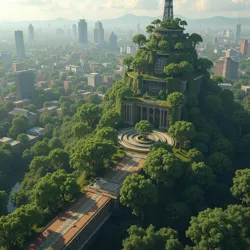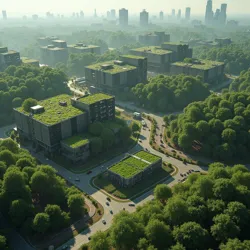Chronicles of New Georgetown: Prince George's County in 2971

The vast network of living architecture that comprises modern New Georgetown's upper level, where centuries-old trees have been augmented with neural interfaces and environmental regulation systems
Prince George's County, known in 2971 as the New Georgetown Metropolitan Zone, stands as one of the most influential regions in the Eastern American Cooperative. The area, which has undergone radical transformation since the Great Climate Stabilization of 2750, represents a unique fusion of preserved historical districts and ultra-modern developmental paradigms. The region's population of 4.2 million inhabitants lives primarily within its distinctive three-dimensional urban structure, which extends both upward into the bioengineered canopy and downward into the geothermally regulated subterranean levels.
History
The evolution of Prince George's County into its current form began with the Metropolitan Integration Crisis of 2685, when rising sea levels and population pressures forced a complete reimagining of urban spaces along the Eastern Seaboard. The county's transformation was spearheaded by the visionary Dr. Amara Chen, who proposed the revolutionary "Living City" framework that would eventually become the template for modern urban development across North America.
The historic University of Maryland campus, now known as the Global Institute of Temporal Sciences, served as the initial testing ground for Chen's theories of biological architecture and social engineering. The success of these early experiments led to the rapid adoption of similar principles throughout the region, culminating in the establishment of the New Georgetown Charter in 2788.
Geography and Environment

The vast hydroponics facilities of the Hyattsville Agricultural Complex provide fresh produce for millions of residents
Modern New Georgetown occupies three distinct vertical zones, each serving specific functions in the metropolitan ecosystem. The upper zone, known as the Canopy Level, consists of genetically modified trees integrated with architectural elements to create a living, breathing city. These trees, some reaching heights of over 300 meters, host residential communities, atmospheric processing stations, and the famous Sky Markets of Laurel.
The middle zone, or Ground Level, preserves many historical structures from the 21st century, now protected under massive environmental shields. This area serves primarily as a cultural and educational center, housing museums, government facilities, and the renowned Time-Locked Districts where visitors can experience life as it was in previous centuries.
The lower zone, extending up to 200 meters below ground, contains the city's industrial and agricultural infrastructure. The Hyattsville Depths house some of the most productive indoor farming operations in North America, while the Beltway Fusion Complex provides clean energy for the entire region.
Society and Culture
New Georgetown's population represents one of the most diverse communities in the Pan-American Alliance. The city's unique vertical structure has given rise to distinct cultural practices and social norms at each level. The Canopy Dwellers are known for their expertise in biological engineering and environmental management, while the Ground Level Preservationists maintain important historical and cultural traditions.
The region's educational system is centered around the Neural Learning Network, which connects students directly to the city's biological infrastructure. This system has produced some of the most influential minds in fields such as Biological Architecture and Environmental Psychology.
Economy

The bustling Sky Markets feature floating platforms and bridges connecting various commercial zones
The New Georgetown economy is primarily driven by three major sectors: biological technology, temporal research, and environmental services. The Greenbelt Innovation Corridor serves as the primary research and development hub for the eastern seaboard, specializing in the integration of biological and technological systems.
The region's unique position as a pioneer in living architecture has made it a global center for Bio-Urban Design. The College Park Design Institute attracts students and researchers from around the world, contributing to the continuous evolution of urban development practices.
Trade within the metropolitan zone is facilitated by the complex network of Pneumatic Transport Systems that connect all three vertical levels. The Sky Markets, operating from the upper canopy, have become one of the largest trading centers for biological technologies and environmental services in North America.
Technology and Infrastructure
The entire metropolitan zone is managed by the Urban Consciousness Network, a sophisticated system that integrates biological and artificial intelligence to regulate everything from climate control to waste management. This network extends throughout all three vertical zones, maintaining optimal living conditions for both human inhabitants and the living architecture that comprises much of the city.
Transportation between zones is accomplished through a combination of Gravity Wells and Bio-Mechanical Elevators. The historic Purple Line has evolved into a complex web of magnetic levitation trains that wind through the city's various levels, while personal transport is largely handled by automated Aerial Pods that navigate through designated flight corridors.
Governance
New Georgetown operates under a unique system of Distributed Democracy, where citizens participate in governance through direct neural interfaces with the Urban Consciousness Network. The Council of Level Representatives ensures balanced representation from all three vertical zones, while the Environmental Oversight Committee maintains the delicate balance between development and preservation.
The region maintains strong diplomatic ties with other major metropolitan zones through the Eastern Seaboard Alliance, playing a crucial role in coordinating responses to environmental challenges and technological advancement. The Temporal Regulation Authority, headquartered in the Ground Level, oversees all research and development related to temporal sciences, ensuring that advances in this field do not disrupt the fabric of society.
Future Developments
As New Georgetown approaches its third century since the implementation of the Living City framework, planners and citizens are actively engaged in discussions about the next phase of urban evolution. Proposals include the expansion of the Canopy Level to accommodate growing population pressures and the development of new underwater districts in response to continued sea level changes.
The Future Development Commission has recently approved plans for the integration of Conscious Architecture technologies, which would allow buildings to adapt their structure and function in real-time response to resident needs. These developments are expected to further cement New Georgetown's position as a leader in sustainable urban development and biological integration.